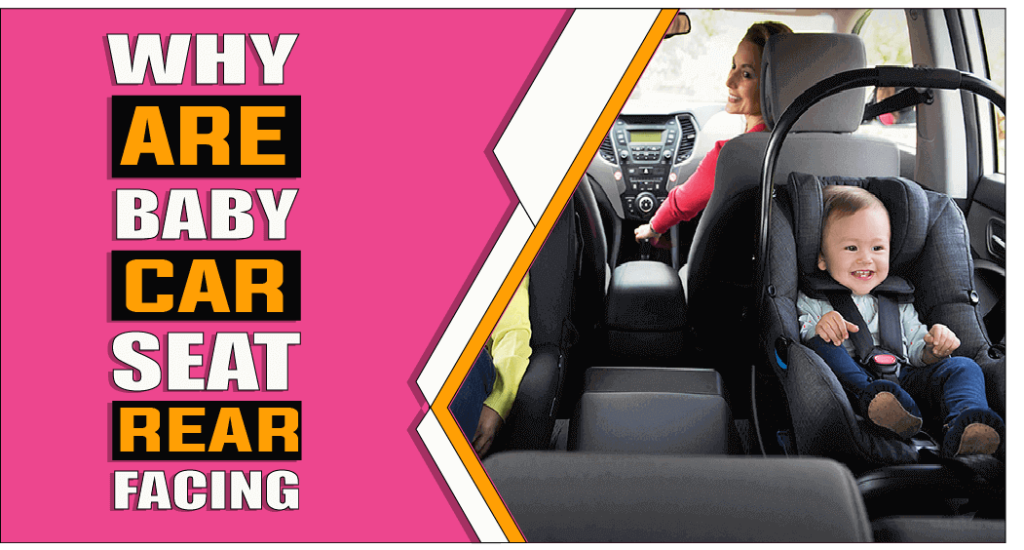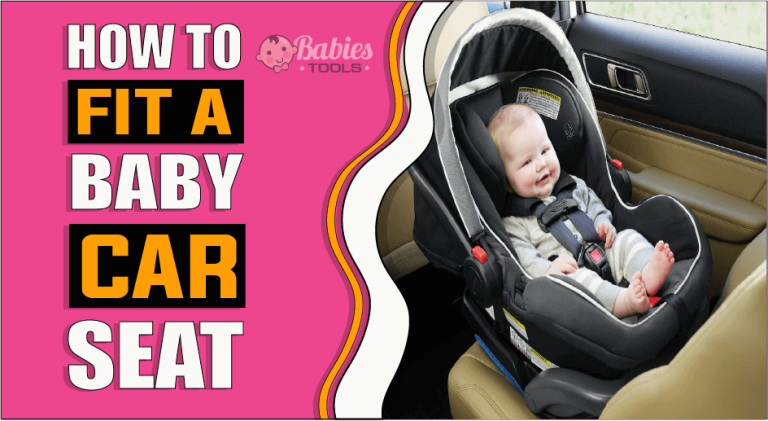Why Are Baby Car Seats Rear Facing – The Truth Reveals
Your child’s safety is always top of mind as a parent, including while in the car. You likely chose a baby car seat approved by government safety standards. However, did you know “why are baby car seats rear-facing”? While many parents may not be aware, according to research from the National Highway Traffic Safety Administration (NHTSA), the best practice is for infants to ride in rear-facing car seats until age two or beyond. In this blog post, we’ll cover why keeping your baby rear-facing is essential and how to ensure your little one is safe on every journey. We also discuss the different types of rear-facing car seats available, key considerations when choosing and using a car seat, and tips for installing and using a rear-facing car seat. Let’s get started!

Let’s explore why are baby car seats rear facing
When it comes to driving with young children, parents have a responsibility to ensure the safety of their kids at all times. One way parents can do this is by ensuring that their child is secured in a car seat with the proper use of a baby car seat. It is essential to make sure that the baby car seat is rear-facing. To understand why let’s look at why rear-facing baby car seats are so important for your child’s safety.
1: Safety-
One of the biggest reasons baby car seats should always be rear-facing is that they provide extra safety for your child in case of a crash or sudden stop. Rear-facing car seats are designed to cushion and protect a child’s body from impact by dispersing the force away from the neck and spine. It can help to reduce the risk of serious injury in a crash.
2: Protection against whiplash-
Rear-facing car seats are also beneficial because they help protect against whiplash injuries in a collision. The cushioning and support provided by rear-facing car seats help to minimize the risk of neck, spine, and head injuries in a crash.
3: Support for their neck and spine-
When a child is rear-facing, their neck and spine are better supported than forward-facing. Rear-facing car seats provide extra support for the child’s head, neck, and spine, which can help to reduce the risk of injury in the event of a crash.
4: Protection from the side-
Impact collisions-Rear-facing baby car seats are also beneficial because they provide extra protection in a side-impact collision. In these crashes, which often occur at intersections or when another vehicle strikes you from the side, rear-facing seats can help protect the child from injury.
5: Improved airbag protection-
Rear-facing baby car seats also provide improved airbag protection. When a child is rear-facing, the back of their seat will absorb the force from an airbag deployment, which helps to reduce the risk of injury.
Parents can do their part to keep their kids safe while in the car by understanding why using rear-facing car seats is so important. Using a rear-facing seat is one of the best ways to ensure your child’s safety on the road. Therefore, a rear-facing baby car seat is essential when keeping your little ones safe!
Types of rear-facing car seats?
Rear-facing car seats are essential for keeping your child safe while in a vehicle. They provide the best protection for children, especially infants, and toddlers, by evenly distributing the force of an accident over the entire body. Rear-facing car seats come in three types – convertible, infant-only, and all-in-one. Let’s take a look at each type in detail.
1: Convertible Car Seats:
Convertible car seats are great because they can be used in multiple configurations. They can face the rear and front of the vehicle, making them suitable for kids up to around 4 years old. They come with adjustable features that allow you to customize the fit and comfort of your child. They also have higher weight limits than the other types of car seats, so they can be used longer. If you plan on using your car seat for a long time, this would be your best car seat.
2: Infant-Only Car Seats:
Infant-only car seats are designed for infants up to 12 months old. They have lower weight limits than convertible car seats and typically come with a detachable base that can be easily installed in the vehicle. They also come with adjustable features like straps and cushions that provide extra protection for your baby.
3: All-in-One Car Seats:
All-in-one car seats are similar to convertible car seats in that they can face the rear and front of the vehicle. However, they are designed with more significant weight limits and can be used for up to 10 years old. They come with adjustable features that make it easy to customize the fit and comfort of your child. They also have higher safety ratings than other car seats, making them a good option if you use your car seat for a long time.
You can choose from three main types of rear-facing car seats – convertible, infant-only, and all-in-one. Each type has unique features and benefits that make it suitable for different ages and sizes of children. It’s essential to consider your child’s age, size, and weight when choosing a car seat and the available safety and comfort features. That way, you can protect your child from any potential accidents.
Key considerations when choosing a rear-facing car seat?
When choosing a rear-facing car seat, several key considerations must be remembered.
1: Ensure the car seat is approved by the National Highway Traffic Safety Administration (NHTSA). Car seats must meet safety standards and be certified to protect children in crashes. They should also have a label or sticker showing that it meets all safety requirements.
2: Make sure your child’s car seat is the right size. Look for labels on the side of the car seat that display height and weight limits, so you’ll know if it suits your child’s age, size, and weight.
3: Consider the features of the car seat. Look for adjustable headrests, padded straps and buckles, and an easy-to-use installation system. It is also essential to ensure the car seat has been crash tested and approved by a third-party testing facility like Consumer Reports or Insurance Institute for Highway Safety.
4: Think about the fit of the car seat in your vehicle. If you plan on moving the car seat from one vehicle to another, look for a car seat with universal latches that fit most vehicles. Also, consider any special features like extra padding or adjustable straps that could help get the right fit in your car easier.
5: Consider the cost of the car seat. Rear-facing safety seats can range from very affordable to quite expensive, so consider your budget. Choosing a rear-facing car seat is an important decision, considering many factors. Be sure to shop around and read reviews to weigh the features and benefits of different models against your needs. With the right car seat, you can be sure your child will be as safe as possible when traveling in a vehicle.
6: Lastly, consider if you can install the car seat correctly. Some car seats require special tools or additional parts to ensure a secure installation. Many department and baby specialty stores offer free car seat inspections where certified technicians can help ensure your car seat is installed correctly. Choosing the right rear-facing car seat for your child is essential and should not be taken lightly. Remember these key considerations when selecting; you can be sure your child will have the safest ride possible.
Important Safety Tips When Using a Rear-Facing Car Seat?
Once you’ve chosen the right rear-facing car seat for your child, it is vital to ensure you use it correctly and safely. Follow these tips to ensure your child’s safety when using a rear-facing car seat:
1: Ensure the harness straps are in the correct position for your child’s size and age. The straps should be snug but not overly tight so that you can fit one finger between them and your child’s chest.
2: Make sure the car seat is at the correct angle for your child’s height. For rear-facing seats, your child’s head should be even with or slightly above the top of the seat when installed correctly in a vehicle.
3: Use the tether strap if your car seat has one. This strap helps to keep the car seat in place and reduces the risk of your child’s head moving forward during a crash.
4: Ensure you follow all instructions when installing or adjusting the car seat, and check for a proper installation every time you use it. Always secure the car seat with either the vehicle’s seat belt or the car seat’s built-in latch system.
5: Ensure your child is securely buckled up in the car seat every time they ride. Adjust straps and harnesses to ensure a snug fit, and check for slack in the straps after every use.
6: Make sure your child is in the correct car seat for size, age, and weight. Using a car seat that fits your child properly and offers the best protection in case of an accident is essential.
7: For parents with toddlers, make sure to transition your child out of the rear-facing position once they reach their car seat’s maximum recommended height and weight limit.
Following these tips can help ensure your child’s safety when riding in a vehicle. Remember that your child’s safety is the top priority when using a rear-facing car seat, so follow all instructions carefully.
Relevant Question:
Most car seat manufacturers recommend that babies up to age 2 ride in a rear-facing seat, as it provides the most protection for young children. Additionally, check your local state laws for specific requirements and recommendations for when to switch from a rear-facing to a forward-facing position. It is always essential to consult your vehicle manual and car seat instructions to ensure the safest ride for your little one.
According to the American Academy of Pediatrics, it is recommended that infants and toddlers ride rear-facing until they reach the maximum height or weight limit allowed by their car seat’s manufacturer. It generally means that children should remain rear-facing until at least age 2 or until they exceed the height and weight limits for their car seat. It is important to note that rear-facing is the safest position for children in a car seat, providing more excellent protection for the head, neck, and spine. Additionally, this position prevents severe injuries from happening in the event of an accident. Therefore, it is best to keep your child rear-facing until they reach the maximum height or weight limit their car seat’s manufacturer allows.
The American Academy of Pediatrics (AAP) recommends that babies remain in a rear-facing car seat until they reach at least two years of age or until they are within the maximum weight and height limit allowed by the manufacturer of their car seat. Parents should keep their children in a rear-facing seat for as long as possible for the best safety. You must check the user manual for your car seat to ensure you have the right seat and use it properly.
Conclusion paragraph:
Rear-facing car seats are essential to maintaining the safety of infants and toddlers when traveling in vehicles. They keep these vulnerable passengers secure and protected in the event of a crash. It is essential to follow the specific guidelines for infant/toddler age, size, and weight when selecting a suitable car seat for your child. Additionally, knowing how to install and use the rear-facing car seat correctly can help optimize your child’s safety while on the road. It may take longer to buckle them up properly since they are rear-facing. However, having patience during this process means maintaining safety at higher levels. Choosing a rear-facing car seat ensures maximum protection for babies and toddlers when traveling in an automobile. So, why are baby car seats rear-facing? The answer is simple: it’s about saving lives!






